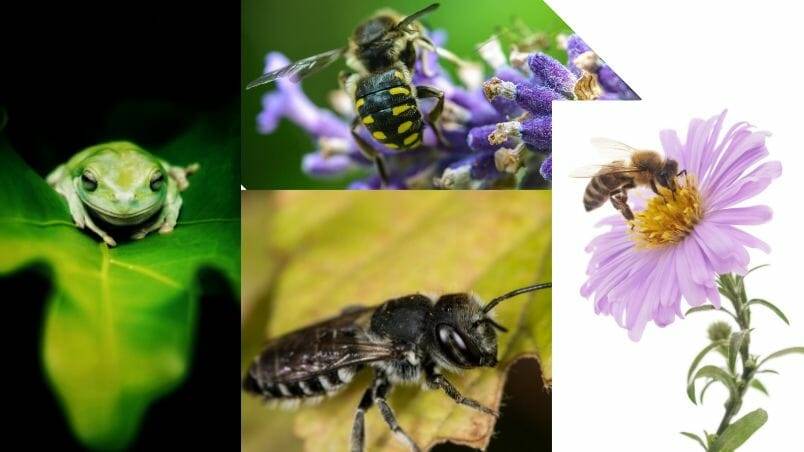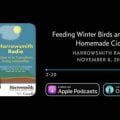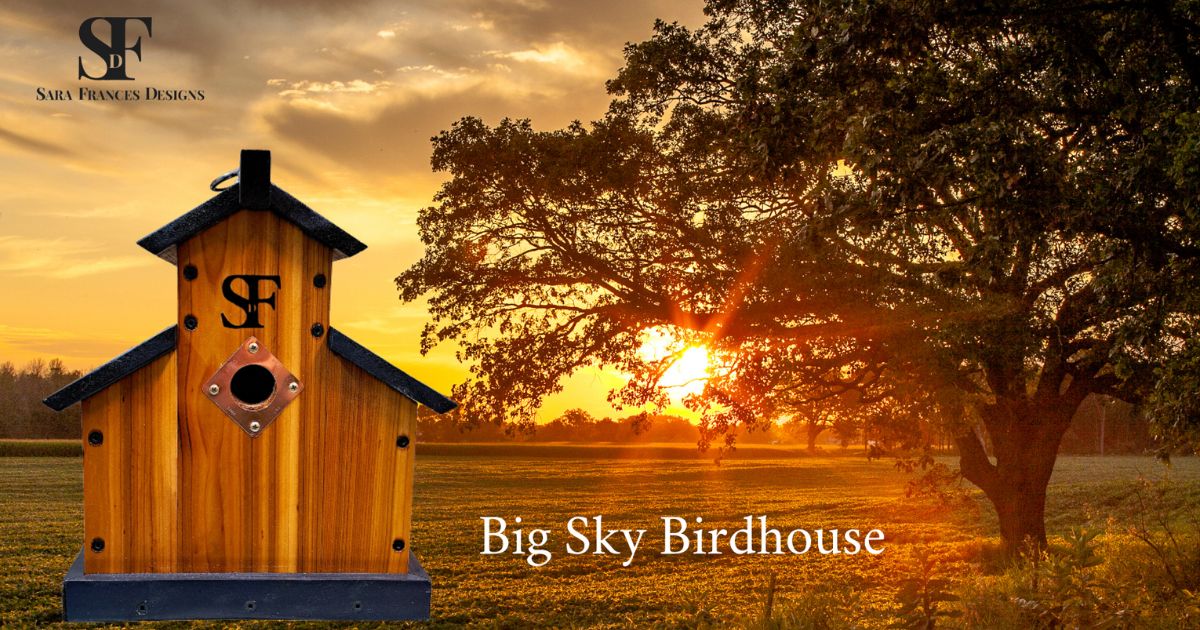When Mark was planning his 10-acre garden, his goal was to surround his home with nature. He made it a priority to seek out plants that would attract hummingbirds, songbirds and butterflies. Insects and other pollinators would simply follow as his criteria for plant selection did not exclude the bees or myriad other pollinating insects. To his friends who question why he has insect hotels around his garden, he is happy to explain why his dream garden embraces rot and decay.
There is a balance between the living and non-living things on this planet. It’s hard to ignore just how important every creature is and how they are part of a web, not a chain, meaning that one creature is not just connected to one other, but to many others. Our gardens should attract wildlife and support part of the complex web of diversity.
As we welcome summer, both good and bad bugs will be invading your gardens. The good bugs are the lacewings, ladybeetles, assassin bugs, syrphid flies, parasitic wasps and so many others. You can attract these critters to your garden by providing them with a suitable habitat and, of course, food.
Fortunately, food for the good bugs is plentiful in our gardens. I’m talking aphids, leaf miners, caterpillars of all sorts, leafhoppers and many more. We need these so-called “bad bugs” to sustain the “good bugs,” and we need all these bugs to support the bird population, which has seen some serious declines in the past few decades.
It’s the food web and every strand is important in its own way, whether it’s good, bad or just plain annoying. Speaking of annoying…
Mosquitoes
We understand the general dislike for mosquitoes, but we defend them by stating that without them a lot of our natural infrastructure would fall apart. For example, the common tree and barn swallow has been in decline for over a decade largely due to the decline in the mosquito (and other flying insect) population.
That said, you may wish to create some space between you and the mosquitoes in your neighbourhood. The following are plants with repellent properties where mosquitoes are concerned. Grow them and enjoy the lack of scratching.
 1. Geranium.
1. Geranium.
The common garden variety geranium is not well liked by mosquitoes. Which is not to say that if you sit next to a geranium the mosquitoes will stay a healthy distance – you have to activate the oils in the leaves by removing one from the plant and rubbing it vigorously on exposed skin. All geraniums have properties that are useful in this regard, but the lemon scented citrosa geranium, which is sometimes called the “mosquito geranium,” could be the most effective of all.
 2. Basil.
2. Basil.
This is one of the few common herbs that provide a pleasant, fresh scent without the oils in the leaves being activated. The plant emits a hunger-inducing smell all day long, but mostly during the heat of the day. Place one in the middle of the table when you next have a garden party. Again, it is the lemon basil that works best.
 3. Citronella Grass (Cymbopogon nardus).
3. Citronella Grass (Cymbopogon nardus).
You likely have a citronella candle stashed in the cupboard of your laundry room or some other mysterious hiding place. The active ingredient in the candle is derived from citronella grass and you can grow it in a sunny spot in your garden or in containers on your patio. But don’t cut it and rub it on your skin as you would the geranium; it can irritate your skin and it causes an allergic reaction in some people.
4. Lavender.
The new introductions that we have trialled in our gardens in recent years bloom for a long time in the first half of the gardening season. We treat lavender as an annual as it almost always dies in our zone 5 gardens, but it can survive nicely in zone 6. It loves the sun and a dry spot. Do not overwater.
 5. Ageratum.
5. Ageratum.
Such an innocent looking little border annual plant actually detracts mosquitoes. There is nothing easier to grow in a hot, dry spot and it blooms all summer. Try some in containers to get it close to your entertainment spaces. Who knew? Keep this off your skin, though: it can cause a rash.
6. Marigolds.
The common French marigold has been a popular annual flowering plant since the Victorians discovered that you really can’t kill them. Planted around your vegetable garden they deter a variety of common insect pests including aphids and white fly. They also deter mosquitoes.
There are other tactics that you can employ in the garden that will help to minimize the mosquito population. Note our careful use of the word “minimize” here: it means that you won’t get rid of them all, and nor should you.
We focused on mosquito control but it is important to mention there are plants that deter other pests from your garden. Grow dill around your roses to reduce the aphid population. We recommend planting dill in a container to prevent it from spreading throughout your garden. Remove the blooms before they go to seed.
Last year, a gardener we met at Canada Blooms gave us some advice about controlling Japanese Beetles. The idea was to plant chives throughout your garden to deter these destructive visitors. We must admit, we did notice less damage on the plants near the chives.
Bats.
Encourage bats to take up residence in your yard. You read this right. Bats consume up to their body weight in insects each evening. Some use their patented sonar system to scoop up insects in their membranous wings; others snatch up bugs with their feet and mouths. They fly at night when most of us are sleeping but mosquitoes are most active.
We recommend that you place some bat houses in tall trees. A bat will reside no less than 7 meters above the ground. If you don’t like the idea of bats living in your yard, ask your neighbour if you can put bat houses in their trees. The bats will never know the difference.
 Swallows.
Swallows.
Chimney swifts, barn and tree swallows are closely related and they are among our very favourite birds. They dip and swirl around us as we cut the lawn and walk through the meadow, dipsy doodling through the air, picking up flying insects as they go. We need to encourage them at every opportunity.
You can attract swallows to your yard with nesting boxes in the spring (they are nesting right now). Place them in an open part of your yard about 2 meters high, with the one and half inch hole facing south or east, out of the west wind. Mark has 38 nesting boxes and about 24 swallow families arrive each spring to set up shop and have babies.
 Frogs and toads.
Frogs and toads.
Once again, we defend the lowly amphibians of the garden. We all need to rise to their defense as they eat an amazing amount of insects, including mosquitoes. Add a water feature to your garden and build an insect hotel. They will come, the insects and toads most certainly, and the frogs will arrive when you have installed a still-water pond.
 Insect Hotels
Insect Hotels
Last winter, Mark made several insect hotels in his woodworking shop for friends and family. They were received graciously and at the same time, with the common query: “What is it? What does an insect hotel do? What kind of insects will it attract? Are they all good for my garden?”
Clearly, this discussion has a long way to go. It started with concern about the decline in the honey bee population and has extended to the general concern shared by Canadians everywhere about the problems with our native population of pollinators.
We are no longer concerned exclusively with the decline of honey bees. Truth is, there are over 700 species of native bees (honey bees are not native) that serve as primary pollinators, many of which you can attract to your yard with an insect hotel. In addition, there are thousands of other invertebrates that either pollinate over 30% of the plants that we rely on for food, or are essential members of the web of insects that make up the whole show.
We say bring on the pollinators!!
Mark Cullen is an expert gardener, author, broadcaster and tree advocate
and holds the Order of Canada. His son, Ben, is a fourth-generation
urban gardener and a graduate of the University of Guelph and Dalhousie
University in Halifax. Follow them at markcullen.com, @MarkCullen4
(Twitter) and @markcullengardening (Facebook) and look for their latest book, Escape to Reality.
Follow them at markcullen.com, @MarkCullen4, facebook.com/markcullengardening and biweekly on Global TV’s national morning show, The Morning Show.






















